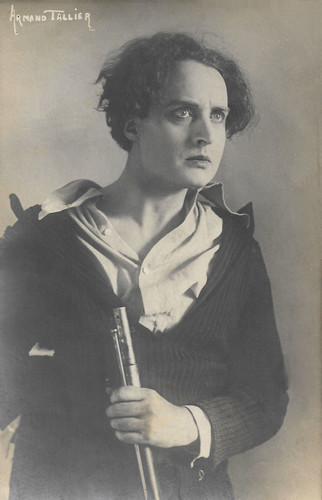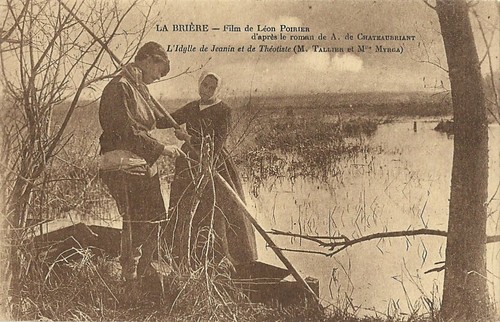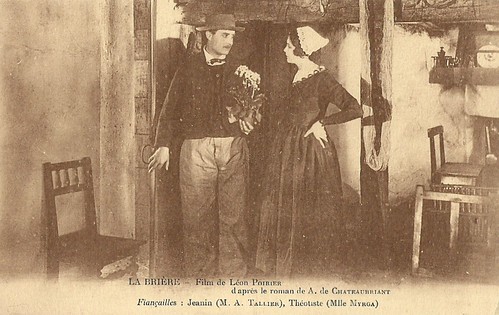Armand Tallier (1887-1958) was a stage and screen actor, who peaked in the silent era. Inspired by theatre director Jacques Copeau, who had opened the alternative Théâtre du Vieux Colombier, and who had directed Tallier on stage from 1913 for several years Tallier created in 1925 the Studio des Ursulines, one of the first Parisian avant-garde cinemas.

Spanish collectors card by Dulces Soler & Co. Chocolates, La India, Guantanamo, no. 3. Photo: Gaumont. Armand Tallier in L'heure du rêve (Léonce Perret, 1915). The film was released in Spain as La hora del ensueño. In the days of old Florence, a prince falls in love with a princess from a neighbouring state, who is locked up in a convent and wants to get out. They don't know they are already destined for each other. Finally they elope, while their people rebel against them and declare their countries republics, but the young couple cannot care less: they are free and in love.

French postcard by Editions Filma, no. 144. Photo: Gaumont. Armand Tallier in Jocelyn (Léon Poirier, 1922)
Armand Tallier was born in 1887 in Marseille, Bouches-du-Rhône, France as Armand Urbain Édouard Espitallier.
From 1911, he acted at Film d'Art (e.g. in films by Henri Pouctal), Gaumont (directed by e.g. Henri Fescourt and Léonce Perret), and Eclair (directed by e.g. Gérard Bourgeois). One of his first films was the short Blanchette (Henri Pouctal, 1912) with Léon Bernard.
In 1916 he played e.g. opposite Huguette Duflos in Madeleine (Jean Kemm, 1916), opposite Yvette Andréyor in Un mariage de raison (Léonce Perret, Louis Feuillade, 1916), and opposite Henry Krauss in Le destin est maître (Jacques Feyder, 1916).
One of his first features was Abel Gance's Mater Dolorosa/The Torture of Silence (Abel Gance, 1917), starring Emmy Lynn as an unfaithful wife who refuses to confess to her husband (Firmin Gémier), and then suffers as a mother. Tallier is the man's brother, whom the wife secretly has loved and who accidentally has killed himself while trying to disarm the woman, who wanted to commit suicide.
In 1917, Armand Tallier was paired with Léon Bernard, whom he already knew from his career in shorts, in Les feuilles tombent (Georges Monca, 1917), followed by La comtesse de Somerive (Georges Denola, 1917), Les vieilles femmes de l'hospice (Jacques Feyder, 1917), and L'instinct est maître (Jacques Feyder, 1917).
In 1918 Tallier was Ebenezer in the fisherman's drama Les travailleurs de la mer (André Antoine, 1918), adapted from Victor Hugo's novel. The plot deals with a Guernseyman named Gilliatt (Romuald Joubé), a social outcast who falls in love with Deruchette (Andrée Brabant), the niece of a local shipowner, Mr. Lethierry (Charles Mosnier). When Lethierry's ship is wrecked on the Roches Douvres, a perilous reef, Deruchette promises to marry whoever can salvage the ship's steam engine. Gilliatt eagerly volunteers, and the story follows both his physical trials and tribulations, but in the end, he understands Deruchette loves another, Ebenezer (Tallier), so he sacrifices himself and crashes into a rock.
In 1918-1919, Tallier could be seen in e.g. Marion de Lorme (Henry Krauss, 1918) starring Nelly Cormon, Le bercail (Marcel L'Herbier, 1919), and Âmes d'orient (Léon Poirier, 1919).

French postcard.

French postcard. The idyll between Jeannin (Armand Tallier) and Théotiste (Laurence Myrga) in La Brière (Léon Poirier, 1925).

French postcard. Betrothal. Jeannin (Armand Tallier) and Théotiste (Laurence Myrga) in La Brière (Léon Poirier, 1925).
Between 1920 and 1926, Armand Tallier only did 9 films but these included some memorable ones, such as Le penseur/The Thinker (Léon Poirier, 1920) with André Nox, and Mathias Sandorf/The Isle of Zorda (Henri Fescourt, 1921) starring Romuald Joubé.
He played the title character in Jocelyn (Léon Poirier, 1922), a period piece after Lamartine, about a young man who is chased from seminary during the French Revolution, and hides in a cave. He hosts a fugitive who proves to be a woman, Laurence (Laurence Myrga). Far from civilisation, their love grows, but Jocelyn still keeps his vows and leaves Laurence. She dies, he buries her in the cave.
In Poirier's La Brière (Léon Poirier, 1925), set in the region of La Brière where rough men and women live on peat cutting, a fierce argument breaks out about the draining of the marshes in service of the manufacture of bricks. The old stubborn Aoustin (José Davert) leads the resistance and refuses to give his daughter Théotiste (Laurence Myrga) to a young peasant, Jeanin (Armand Tallier), in favour of the draining. When a pregnant Théotiste is still refused marriage and Aoustin even wants to have Jeanin arrested for poaching, the latter shoots Aoustin his hand off. Théotiste has a miscarriage and is accused of killing her child, after which Jeanin and the whole community shun her. Aoustin gets a wooden hand. He wants to kill Jeanin, but first needs to bring Théotiste to a hospital through the marshes. He gets lost in the freezing cold while his daughter dies. In the end Aoustin lets Jeanin go. The film was typical for the peak in realist rural dramas around 1924.
In 1926, Armand Tallier did his last two silent films. In La chaussée des géants (1926) he starred as François Gérard, who in childhood met Antiope, a little foreigner, in a Paris park. As an adult (Tallier), he sees her (Jeanne Helbling) again in her native country, Mingrelia, which is on the verge of revolution. He is then the host of Count of Antrim (André Volbert), who is also Antiope's father. However, once in the presence of François, the young woman does not seem particularly moved, which somewhat puzzles him. A revolution breaks out, but the conjurers are executed or imprisoned. Back in France, François learns about the true identity of Antiope. The film's title refers to the real Chaussée des Géants (Giant's Causeway), in the County of Antrim in Ireland.
In his final film, Le soleil de minuit (Richard Garrick, Jean Legrand, 1926), Tallier again had the male lead. Irène Sorbier (Gina Manès) sacrifices her honour to save her father from ruin. A few months afterwards, she meets a charming young man named André Varennes (Tallier) and they both take a fancy towards each other. On their wedding night, Irène confesses her past to André who leaves her. They meet again after a year and Irène gets to explain and plead her case. Although André forgives her, he leaves for a cruise on his yacht alone. She tries to follow him on a small boat but a storm capsizes it and in the nick of time André rescues the woman whom he has always loved. Both last films with Tallier were based on novels by Pierre Benoît, famous for his novels 'L'Atlantide' and 'Koenigsmark', which were adapted to film several times.
Tallier's only worked on one sound film, Sœurs d’armes (Léon Poirier, 1937), with Thomy Bourdelle. Tallier did not act in this film, but was the assistant director. The film was based on the lives of Louise De Bettignies (Jeanne Sully) and Leonie Vanhoutte (Josette Day), who were spies during WWI in the service of their homeland. They were arrested and imprisoned till the end of the war. Louise De Bettignies died of typhus fever, a few days after the victory. The film was made to stir patriotic feelings in the years just before WW2.
Armand Tallier died in Paris in 1958. He was 70. In 1925, Tallier created with Laurence Myrga the Studio des Ursulines, one of the first Parisian art houses, founded to ensure the diffusion of avant-garde cinema. The first screening took place in January 1926. As an homage, since 1958 the best book on film is awarded with the Prix Armand Tallier (since 1977 called Prix littéraire du syndicat français de la critique de cinéma).

French postcard. Photo: Film Gaumont.

French postcard by Editions Cinémagazine, no. 399.
Sources: Jean-Pascal Constantin (Les Gens du Cinéma - French), Wikipedia (French) and IMDb. For Mater Dolorosa/The Torture of Silence (1917), see YouTube.

Spanish collectors card by Dulces Soler & Co. Chocolates, La India, Guantanamo, no. 3. Photo: Gaumont. Armand Tallier in L'heure du rêve (Léonce Perret, 1915). The film was released in Spain as La hora del ensueño. In the days of old Florence, a prince falls in love with a princess from a neighbouring state, who is locked up in a convent and wants to get out. They don't know they are already destined for each other. Finally they elope, while their people rebel against them and declare their countries republics, but the young couple cannot care less: they are free and in love.

French postcard by Editions Filma, no. 144. Photo: Gaumont. Armand Tallier in Jocelyn (Léon Poirier, 1922)
The Torture of Silence
Armand Tallier was born in 1887 in Marseille, Bouches-du-Rhône, France as Armand Urbain Édouard Espitallier.
From 1911, he acted at Film d'Art (e.g. in films by Henri Pouctal), Gaumont (directed by e.g. Henri Fescourt and Léonce Perret), and Eclair (directed by e.g. Gérard Bourgeois). One of his first films was the short Blanchette (Henri Pouctal, 1912) with Léon Bernard.
In 1916 he played e.g. opposite Huguette Duflos in Madeleine (Jean Kemm, 1916), opposite Yvette Andréyor in Un mariage de raison (Léonce Perret, Louis Feuillade, 1916), and opposite Henry Krauss in Le destin est maître (Jacques Feyder, 1916).
One of his first features was Abel Gance's Mater Dolorosa/The Torture of Silence (Abel Gance, 1917), starring Emmy Lynn as an unfaithful wife who refuses to confess to her husband (Firmin Gémier), and then suffers as a mother. Tallier is the man's brother, whom the wife secretly has loved and who accidentally has killed himself while trying to disarm the woman, who wanted to commit suicide.
In 1917, Armand Tallier was paired with Léon Bernard, whom he already knew from his career in shorts, in Les feuilles tombent (Georges Monca, 1917), followed by La comtesse de Somerive (Georges Denola, 1917), Les vieilles femmes de l'hospice (Jacques Feyder, 1917), and L'instinct est maître (Jacques Feyder, 1917).
In 1918 Tallier was Ebenezer in the fisherman's drama Les travailleurs de la mer (André Antoine, 1918), adapted from Victor Hugo's novel. The plot deals with a Guernseyman named Gilliatt (Romuald Joubé), a social outcast who falls in love with Deruchette (Andrée Brabant), the niece of a local shipowner, Mr. Lethierry (Charles Mosnier). When Lethierry's ship is wrecked on the Roches Douvres, a perilous reef, Deruchette promises to marry whoever can salvage the ship's steam engine. Gilliatt eagerly volunteers, and the story follows both his physical trials and tribulations, but in the end, he understands Deruchette loves another, Ebenezer (Tallier), so he sacrifices himself and crashes into a rock.
In 1918-1919, Tallier could be seen in e.g. Marion de Lorme (Henry Krauss, 1918) starring Nelly Cormon, Le bercail (Marcel L'Herbier, 1919), and Âmes d'orient (Léon Poirier, 1919).

French postcard.

French postcard. The idyll between Jeannin (Armand Tallier) and Théotiste (Laurence Myrga) in La Brière (Léon Poirier, 1925).

French postcard. Betrothal. Jeannin (Armand Tallier) and Théotiste (Laurence Myrga) in La Brière (Léon Poirier, 1925).
The first Parisian art house
Between 1920 and 1926, Armand Tallier only did 9 films but these included some memorable ones, such as Le penseur/The Thinker (Léon Poirier, 1920) with André Nox, and Mathias Sandorf/The Isle of Zorda (Henri Fescourt, 1921) starring Romuald Joubé.
He played the title character in Jocelyn (Léon Poirier, 1922), a period piece after Lamartine, about a young man who is chased from seminary during the French Revolution, and hides in a cave. He hosts a fugitive who proves to be a woman, Laurence (Laurence Myrga). Far from civilisation, their love grows, but Jocelyn still keeps his vows and leaves Laurence. She dies, he buries her in the cave.
In Poirier's La Brière (Léon Poirier, 1925), set in the region of La Brière where rough men and women live on peat cutting, a fierce argument breaks out about the draining of the marshes in service of the manufacture of bricks. The old stubborn Aoustin (José Davert) leads the resistance and refuses to give his daughter Théotiste (Laurence Myrga) to a young peasant, Jeanin (Armand Tallier), in favour of the draining. When a pregnant Théotiste is still refused marriage and Aoustin even wants to have Jeanin arrested for poaching, the latter shoots Aoustin his hand off. Théotiste has a miscarriage and is accused of killing her child, after which Jeanin and the whole community shun her. Aoustin gets a wooden hand. He wants to kill Jeanin, but first needs to bring Théotiste to a hospital through the marshes. He gets lost in the freezing cold while his daughter dies. In the end Aoustin lets Jeanin go. The film was typical for the peak in realist rural dramas around 1924.
In 1926, Armand Tallier did his last two silent films. In La chaussée des géants (1926) he starred as François Gérard, who in childhood met Antiope, a little foreigner, in a Paris park. As an adult (Tallier), he sees her (Jeanne Helbling) again in her native country, Mingrelia, which is on the verge of revolution. He is then the host of Count of Antrim (André Volbert), who is also Antiope's father. However, once in the presence of François, the young woman does not seem particularly moved, which somewhat puzzles him. A revolution breaks out, but the conjurers are executed or imprisoned. Back in France, François learns about the true identity of Antiope. The film's title refers to the real Chaussée des Géants (Giant's Causeway), in the County of Antrim in Ireland.
In his final film, Le soleil de minuit (Richard Garrick, Jean Legrand, 1926), Tallier again had the male lead. Irène Sorbier (Gina Manès) sacrifices her honour to save her father from ruin. A few months afterwards, she meets a charming young man named André Varennes (Tallier) and they both take a fancy towards each other. On their wedding night, Irène confesses her past to André who leaves her. They meet again after a year and Irène gets to explain and plead her case. Although André forgives her, he leaves for a cruise on his yacht alone. She tries to follow him on a small boat but a storm capsizes it and in the nick of time André rescues the woman whom he has always loved. Both last films with Tallier were based on novels by Pierre Benoît, famous for his novels 'L'Atlantide' and 'Koenigsmark', which were adapted to film several times.
Tallier's only worked on one sound film, Sœurs d’armes (Léon Poirier, 1937), with Thomy Bourdelle. Tallier did not act in this film, but was the assistant director. The film was based on the lives of Louise De Bettignies (Jeanne Sully) and Leonie Vanhoutte (Josette Day), who were spies during WWI in the service of their homeland. They were arrested and imprisoned till the end of the war. Louise De Bettignies died of typhus fever, a few days after the victory. The film was made to stir patriotic feelings in the years just before WW2.
Armand Tallier died in Paris in 1958. He was 70. In 1925, Tallier created with Laurence Myrga the Studio des Ursulines, one of the first Parisian art houses, founded to ensure the diffusion of avant-garde cinema. The first screening took place in January 1926. As an homage, since 1958 the best book on film is awarded with the Prix Armand Tallier (since 1977 called Prix littéraire du syndicat français de la critique de cinéma).

French postcard. Photo: Film Gaumont.

French postcard by Editions Cinémagazine, no. 399.
Sources: Jean-Pascal Constantin (Les Gens du Cinéma - French), Wikipedia (French) and IMDb. For Mater Dolorosa/The Torture of Silence (1917), see YouTube.
No comments:
Post a Comment